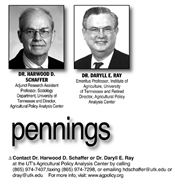|
Pharmaceutical And Food Markets Are Surprisingly Similar And Yet SO Different

In late June 2020, Gilead Sciences announced the price of “Remdesivir, the first drug shown to be effective against the coronavirus” (https://tinyurl.com/ycs7urvp). The response to the price announcement bore a similarity to the Goldilocks story; some thought the price was too high, some thought it was too low, while others thought it was just right.
The drug has been shown to shorten the hospital stay of coronavirus patients by an average of four days. Those who thought the price for a typical course of treatment was just right argued that the price was less than the cost of the additional days of hospitalization.
The issue of pricing had us making mental comparisons of the similarities between the markets for food and those for pharmaceuticals; both are essential for life. In talks that we give to anyone who will listen, we illustrate the low price elasticity of demand for food by saying: food is like insulin, whether the price is high or low, the amount of insulin people purchase generally remains the same. Both are coercive goods and when people are priced out of the market, the ultimate consequence is death.
Where the difference comes in is on the production side. With agriculture, the number of producers is large, and the price is chronically low. In the pharmaceutical industry, the number of manufacturers holding the initial patent for a drug is “one” and the price is based on what the market will bear. Farmers are price takers while pharmaceutical firms are price setters.
The difference in the relative price level is not the importance of the product for life, but rather the number of producers. As a result, with crop and dairy production we see farmers asking the government to intervene in the market with income or price supporting policies. In the prescription drug market, it is the consumers who are asking the government to negotiate prices with the pharmaceutical firms.
This call for intervention in the pharmaceutical market is driven in part by the egregious behavior of some firms as well as the increase in drug prices that exceed increases in wages and the general cost of living. A 2016 article by Meghana Keshaven (https://tinyurl.com/zmzknas) reported that Mylan, the manufacturer of the EpiPen, increased the price of its epinephrine injector by more than 400 percent between 2007 and 2016. Similarly, she reported that Mylan increased “the list price for its gallstone drug ursodiol [by] 542 percent, its irritable bowel syndrome drug dicyclomine [by] 400 percent, [while] its antihypertensive drug verapamil has tripled in price.”
But none of that attracted the attention of the public like Martin Shkreli’s increase in the price of Daraprim – an off-patent drug used in the treatment of infections in AIDS patients – by 5,000 percent. At the time, there was no generic manufacturer to moderate the price increase.
With the COVID-19 pandemic and the rush to develop drugs to treat the disease along with vaccines to prevent it, the question of the pricing of pharmaceuticals will remain front and center in public discourse.
For us, the comparison of these two product categories reminds us that free markets do not always produce optimum results. But the founder of modern economic theory, Adam Smith, would not be surprised by this. In his Wealth of Nations, he asserted that some products were necessities. Thus, workers and by extension their families must be able to afford them in order to reproduce the next generation of workers.
While this is an extremely utilitarian view of our fellow human beings, the point is clear. In our modern society there needs to be a balance between income on the one hand and prices on the other. When markets are not capable of achieving this balance, sensible but effective governmental policies are required. ∆
DR. HARWOOD D. SCHAFFER: Adjunct Research Assistant Professor, Sociology Department, University of Tennessee and Director, Agricultural Policy Analysis Center
DR. DARYLL E. RAY: Emeritus Professor, Institute of Agriculture, University of Tennessee and Retired Director, Agricultural Policy Analysis Center
|
|